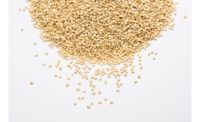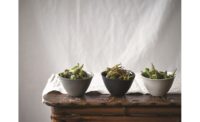We were recently able to interview Greg Kaminski, executive research chef at Synergy Flavors, about what will be the hot new flavors for 2018, as well as what was chosen for 2017's popular flavors.
Hot and new flavors for 2018 include burnt caramel, blood orange, and elderflower.
Liz Parker: For the 2018 new flavor profiles—burnt caramel, blood orange, and elderflower—how can these profiles work across specific snacks and baked goods?
Greg Kaminski: I've been testing different prototypes for the last couple of weeks for the three flavor profiles. For each profile, I have been experimenting with candies. The burnt caramel is obviously a caramel-based food, and it works well in cakes. Recently, we have used blood orange flavors in gummy bears with great results. We have also put elderflower flavor into chocolate, and then took the chocolate and wrapped it around caramel. The burnt caramel flavor with chocolate is another great combination.
The elderflower, which we typically see in cocktails, was really successful when it was used in cakes. For example, I made mini cream cakes, which were frosted with white icing on top. The elderflower flavor was incorporated into the cake batter as well as the icing, and the flavor "popped" really nicely. The cake had nice floral and lemon notes that were greatly complemented by the elderflower. We have also seen elderflower show up in hard candies as well. Each of these flavors really translate well across all mediums: from cocktails, to bakery goods, to candy, and even ice cream.
LP: You mentioned that you could see these new flavors being used in restaurant menus and on grocery store shelves. What kind of restaurant dishes could you see these being used in?
GK: These flavors are the ones I have found showing up in grocery stores, particularly in snack foods. For example, I saw a blood orange flavored cracker at Whole Foods. The elderflower, which is the core flavor in St. Germaine liqueur, can now be found in some soft drinks. It is also in different grocery store products such as Fever Tree, which is an elderflower tonic water. These examples demonstrate you can successfully combine elderflower with other flavors and ingredients in both cocktails and non-alcoholic drinks.
I think the industry is going to start seeing these flavors more and more. The burnt caramel is obviously a great dessert vehicle already. I created a burnt caramel candy, similar to a Milk Dud, which was my own version of a Milk Dud. You'll see more of that popping up as well both on restaurant menus and retail shelves. People like to hear a story that goes along with desserts, and burnt caramel tells a story. If you let something cook a little too long on the stove, it can actually turn into something that is quite delicious and something that people want to eat.
LP: You mentioned how millennials are really interested in different flavor profiles. Do you think these three "new" flavors will be popular among the general population, too? Or just millennials?
GK: No, I think these flavors are appealing to everybody. Blood orange is very ethnic. I was talking with people from Lebanon, and blood orange is pretty common in the Middle East and Europe. Here in the United States, people really haven't heard of blood orange. Some people have seen it, but to many, it sounds a bit "out there.” I think with millennials digging into it already, mainstream America is going to try it and start to embrace it. It is actually a much juicier, more flavorful orange than what we are used to, which is one of the reasons everybody is going to become interested in blood orange.
LP: Are there any other floral-type flavors that you think will also be popular in 2018, or that have been in the past?
GK: One of the key flavor trends from last year was floral. At Synergy Flavors, we did a whole quarter focus on different floral flavors. We had lavender, elderflower, orange flower and honey flower. While these floral flavors were trending last year, we will definitely be seeing more of them in 2018. Moving forward, the elderflower will be popular, but so will violet and lavender. You'll see them still popping up on menus throughout 2018.
More information about the 2018 trending flavors:
- Burnt caramel: According to Mintel, millennials are interested in different profiles, ethnic infusions and the inferred flavors that are imparted by using specific preparation techniques like caramelization, burning or browning. A burnt caramel flavor pairs the sweet, milky notes of the caramel with the deep and slightly smoky characteristics of burning the caramel. This flavor creation process allows consumers to distinguish the burnt and caramel flavors while enjoying one finished product that combines the best of both.
- Blood orange: Blood orange appeals to consumers by tapping into their growing demand for naturally grown and better-for-you ingredients. Besides the provocative and enticing name, consumers also enjoy how juicy and flavorful blood orange is as compared to the more common Valencia orange flavor.
- Elderflower: Floral flavor use in food and beverage applications has grown 88 percent over the past year, as reported by Mintel. One of these increasingly popular floral flavors is elderflower. Unlike some other floral flavors that can be overwhelming, elderflower’s sweet, subtle profile allows consumers to enjoy it as a standalone flavor. Synergy expects to see increased demand for elderflower flavoring, especially in baked goods and other sweets.
- Floral flavors that will be popular in 2018 include lavender, violet, elderflower, orange blossom, and honeysuckle.







